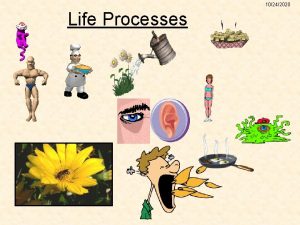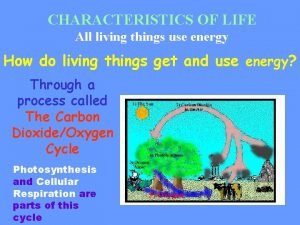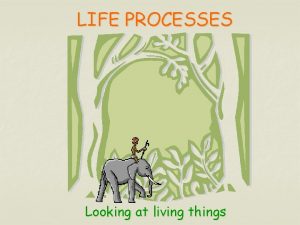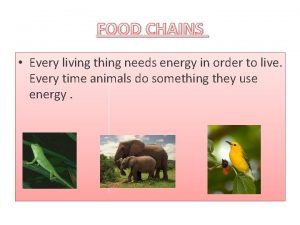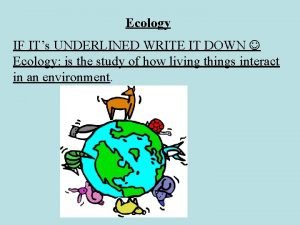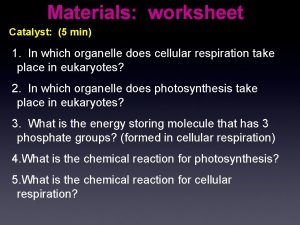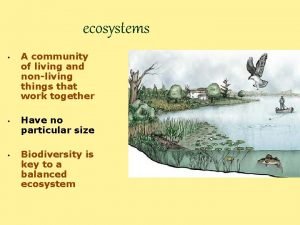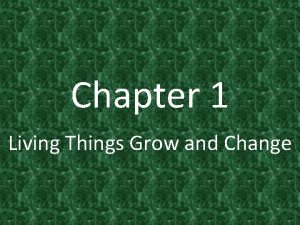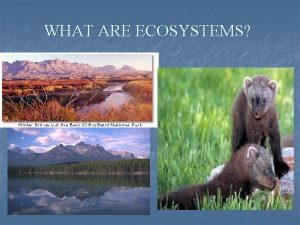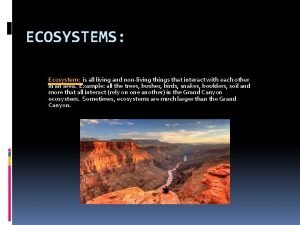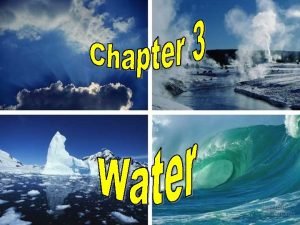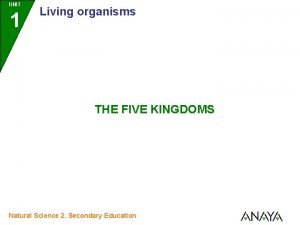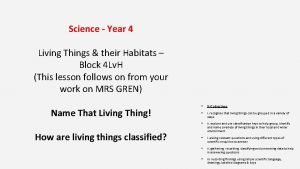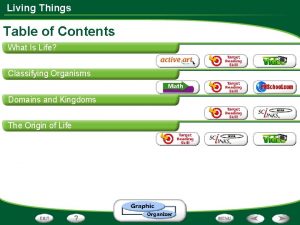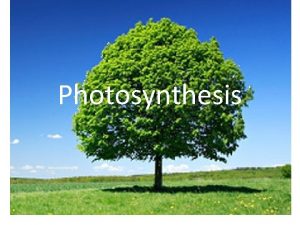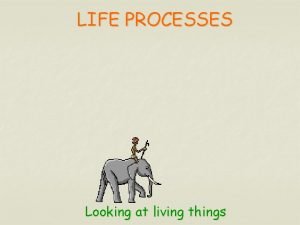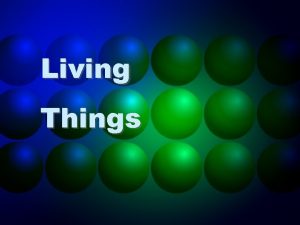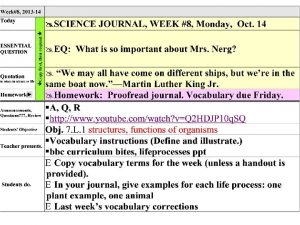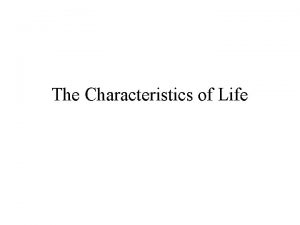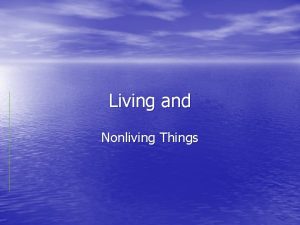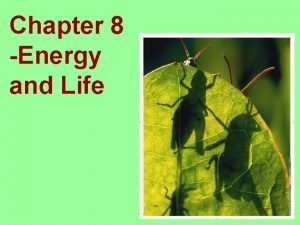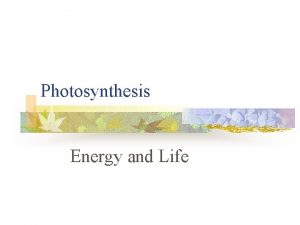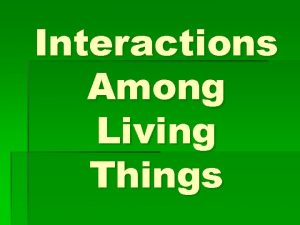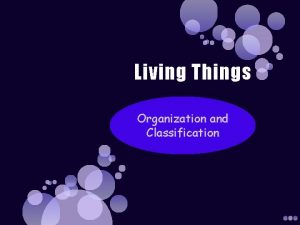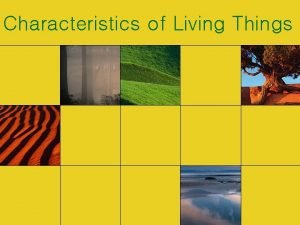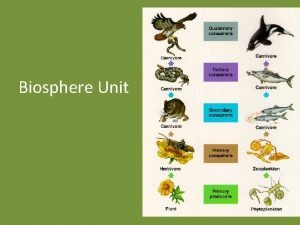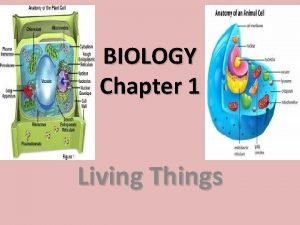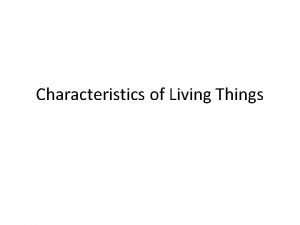Energy and Life Living things need energy to




























- Slides: 28

Energy and Life Living things need energy to survive comes from food energy in most food comes from the sun Plants use light energy from the sun to produce food autotrophs organisms that make their own food Ex - plants heterotrophs organisms that must obtain energy from the foods they consume animals 1

9 -1 Chemical Pathways Food serves as a source of raw materials for the cells in the body and as a source of energy. Animal Cells Animal Mitochondrion Plant 2 Plant Cells

Chemical Energy and ATP Energy – the ability to do work Forms: light, heat, electricity, chemical compounds chemical compound that cells use to store and release energy is adenosine triphosphate (ATP) ATP - basic energy source for all cells 3

Chemical Energy and ATP consists of: adenine ribose 3 phosphate groups Adenine 4 ATP (a 5 -carbon sugar) Ribose The three phosphate groups are the key to ATP's ability to store and release energy. 3 Phosphate groups

Chemical Energy and ATP Storing Energy ADP has two phosphate groups instead of three. A cell can store small amounts of energy by adding a phosphate group to ADP. ATP ADP + Adenosine Diphosphate (ADP) + Phosphate Partially charged battery 5 Energy Fully charged battery Adenosine Triphosphate (ATP)

Chemical Energy and ATP Releasing Energy stored in ATP is released by breaking the chemical bond between the second and third phosphates. 2 Phosphate groups P ADP 6

Chemical Energy and ATP energy uses: - cellular activities: active transport, protein synthesis - muscle contraction Most cells have only a small amount of ATP, because it is not a good way to store large amounts of energy. Cells can regenerate ATP from ADP as needed by using the energy in foods like glucose. 7

Cellular Respiration So what do our cells do with the Oxygen and why do they give off Carbon Dioxide? Answer: To make ATP! 08 March 2021

08 March 2021

Cellular Respiration C 6 H 12 O 6 + 6 O 2 6 CO 2 + 6 H 2 O + usable energy (ATP) 08 March 2021

Cellular Respiration (3 -stages) Glycolysis Krebs Cycle (Citric Acid Cycle) Electron Transport Chain (ETC) 08 March 2021

Overview of Cellular Respiration If oxygen is present: cellular respiration - the process that releases energy by breaking down glucose and other food molecules in the presence of oxygen glycolysis Krebs cycle electron transport chain equation: 6 O 2 + C 6 H 12 O 6 → 6 CO 2 + 6 H 2 O + Energy oxygen + glucose → carbon dioxide + water + Energy 12

Flowchart Section 9 -2 Cellular Respiration Glucose (C 6 H 1206) + Oxygen (02) Glycolysis Krebs Cycle Electron Transport Chain Carbon Dioxide (CO 2) + Water (H 2 O) + ATP

08 March 2021

Glycolysis: Figure 9– 3 Glycolysis Step 1 Glucose 2 Pyruvic acid To the electron transport chain

Figure 9– 3 Glycolysis Section 9 -1 Glucose 2 Pyruvic acid To the electron transport chain

Figure 9– 3 Glycolysis Section 9 -1 Glucose 2 Pyruvic acid To the electron transport chain

Where Cytoplasm NO O 2 required Energy Yield net gain of 2 ATP at the expense of 2 ATP 6 -C glucose TWO 3 -C pyruvates Free e- and H+ combine with organic ion carriers called NAD+ NADH + H+ (nicotinamide dinucleotide) 08 March 2021

Summary In Glucose (6 -C) 2 ATP Out 2 pyruvate; 2(3 -C) 2 NADH a net of 2 ATP 08 March 2021

08 March 2021

Breakdown of Pyruvic Acid Where mitochondria Pyruvate (3 -C) Acetic acid (2 -C) 3 rd C forms CO 2 Acetic acid combines with Coenzyme A to form ACETYL-Co. A 08 March 2021

The Krebs Cycle Section 9 -2 Citric Acid Production Mitochondrion

Krebs Cycle 08 March 2021

Second Step: Citric Acid Cycle (Krebs Cycle) Where Mitochondrial matrix Energy Yield 2 ATP and more e Acetyl-Co. A (2 -C) combines with 4 -C to form 6 -C CITRIC ACID Citric Acid (6 -C) changed to 5 -C then to a 4 -C Gives off a CO 2 molecule NAD+ and FAD pick up the released e FAD becomes FADH 2 NAD+ becomes NADH + H+ Cycle ALWAYS reforming a 4 -C molecule 08 March 2021

ETC Where inner membrane of mitochondria Energy Yield Total of 32 ATP O 2 combines with TWO H+ to form H 2 O Exhale - CO 2, H 2 O comes from cellular respiration 08 March 2021

Electron Transport Chain Section 9 -2 Electron Transport Hydrogen Ion Movement Channel Mitochondrion Intermembrane Space ATP synthase Inner Membrane Matrix ATP Production

Summary Mitochondrion Electrons carried in NADH Pyruvic acid Glucose Glycolysis Krebs Cycle Electrons carried in NADH and FADH 2 Electron Transport Chain Mitochondrion Cytoplasm

Aerobic vs. Anaerobic DOES Aerobic requires NOT require oxygen Fast, but oxygen Yields large produces smaller amounts of energy (ATP) amounts of energy 08 March 2021
 Whats an energy pyramid
Whats an energy pyramid Smallest living unit of life
Smallest living unit of life Seven life process
Seven life process Do plants move on their own
Do plants move on their own Life cycle of all living things
Life cycle of all living things What does mrs nerg stand for
What does mrs nerg stand for How many links are there in a food chain
How many links are there in a food chain What is the producer in the food web
What is the producer in the food web Gets its energy from eating living things
Gets its energy from eating living things How living things obtain energy worksheet answers
How living things obtain energy worksheet answers How do heterotrophs and autotrophs differ
How do heterotrophs and autotrophs differ Ecosystem living and nonliving things
Ecosystem living and nonliving things Ecosystem living and nonliving things
Ecosystem living and nonliving things Living things that have leaves and roots
Living things that have leaves and roots Unicellular multicellular
Unicellular multicellular Things that grow and change
Things that grow and change Non living things in grassland
Non living things in grassland Things in ecosystem
Things in ecosystem Is a candle living or nonliving
Is a candle living or nonliving Living non living dead
Living non living dead Postman undo changes
Postman undo changes Why is water important to living things
Why is water important to living things What are the five kingdoms of living things
What are the five kingdoms of living things Life's structure and classification answers key
Life's structure and classification answers key Living things meaning
Living things meaning These are organic compounds made by living things
These are organic compounds made by living things Classification of living things table
Classification of living things table Jackal linnaean system
Jackal linnaean system 6 kingdoms of taxonomy
6 kingdoms of taxonomy



